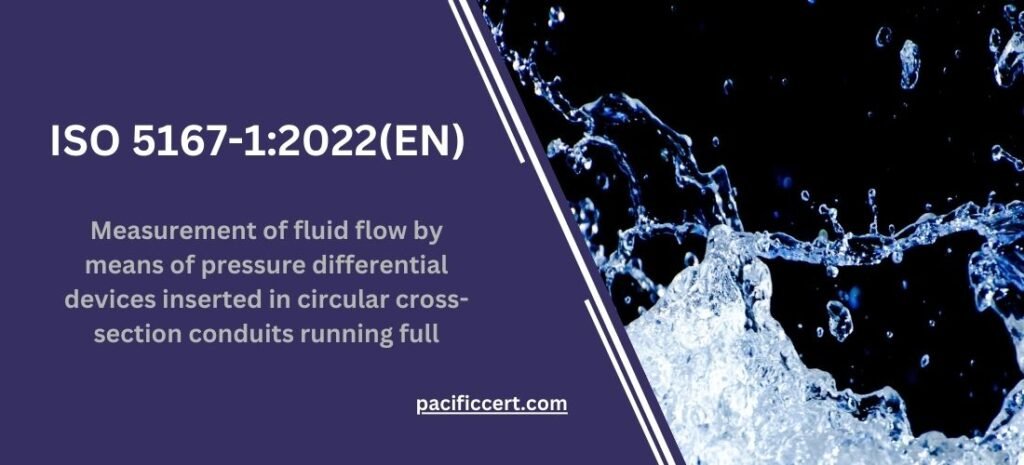
Measurement of fluid flow by means of pressure differential devices inserted in circular cross-section conduits running full
ISO 5167-1:2022(EN) was created by Technical Committee ISO/TC 30, Measurement of fluid flow in closed conduits, Subcommittee SC 2, Pressure differential devices, in collaboration with the European Committee for Standardization (CEN) Technical Committee CEN/SS F05, Measuring instruments, in accordance with the Agreement on technical cooperation between ISO and CEN
It is the third edition which canceled and replaced the second edition, ISO 5167-1:2003 The main changes are:
- improved consistency between ISO 5167-1 to ISO 5167-6
- a primary element has been set as part of a differential pressure metering system
- a short section on diagnostics and CBM (Condition Based Monitoring) has been included
- a limitation on the use of the 5 % 2° rule for an acceptable profile has been noted
- improved text about uncertainty calculation and an example in Annex E has been provided
- annexes on turndown and permanent pressure loss have been included
ISO 5167-1:2022(EN), consisting of six parts, covers the geometry and method of use (installation and operating conditions) of orifice plates, nozzles, Venturi tubes, cone meters and wedge meters when they are inserted in a conduit running full to determine the flow rate of the fluid flowing in the conduit. It also gives necessary information for calculating the flow rate and its associated uncertainty.
ISO 5167-1:2022(EN) is applicable only to pressure differential devices in which the flow remains subsonic throughout the measuring section and where the fluid can be considered as single-phase. But is not applicable to the measurement of pulsating flow. Furthermore, each of these devices can only be used uncalibrated within specified limits of pipe size. And Reynolds number, or alternatively they can be used across their calibrated range.
Also,
ISO 5167-1:2022 deals with devices for which direct calibration experiments have been made, sufficient in number, spread and quality. To enable coherent systems of application to be based on their results and coefficients to be given with certain predictable limits of uncertainty. The ISO 5167-1:2022 also provides methodology for bespoke calibration of differential pressure meters.
The devices introduced into the pipe are called primary devices. The term primary device also includes the pressure tappings. All other instruments or devices required to facilitate the instrument readings are known as secondary devices. And the flow computer that receives these readings and performs the algorithms is known as a tertiary device.
ISO 5167-1:2022(EN) covers primary devices; secondary devices and tertiary devices will be mentioned only occasionally.
ISO 5167-1:2022 defines terms and symbols and establishes the general principles for methods of measurement and computation of the flow rate of fluid flowing in a conduit by means of pressure differential devices when they are inserted into a circular cross-section conduit running full ISO 5167-1:2022 also specifies the general requirements for methods of measurement, installation and determination of the uncertainty of the measurement of flow rate.
In addition, ISO 5167-1:2022(EN) is applicable only to flow that remains subsonic throughout the measuring section and where the fluid can be considered as single-phase. It is not applicable to the measurement of pulsating flow.
ISO 5167-3:2020(EN) Measurement of fluid flow by means of pressure differential devices inserted in circular cross-section conduits running full — Part 3: Nozzles and Venturi nozzles
ISO 5167-3:2020 specifies the geometry and method of use (installation and operating conditions) of nozzles and Venturi nozzles. When they are inserted in a conduit running full to determine the flowrate of the fluid flowing in the conduit.
The ISO 5167-3:2020 also provides background information for calculating the flowrate. And is applicable in conjunction with the requirements given in ISO 5167-1.
ISO 5167-3:2020 is applicable to nozzles and Venturi nozzles in which the flow remains subsonic throughout the measuring section and where the fluid can be considered as single-phase.
In addition, each of the devices can only be used within specified limits of pipe size and Reynolds number. It is not applicable to the measurement of pulsating flow. It does not cover the use of nozzles and Venturi nozzles in pipe sizes less than 50 mm or more than 630 mm. Or where the pipe Reynolds numbers are below 10 000.
ISO 5167-3:2020 deals with
a) Three types of standard nozzles:
1) ISA 19325 nozzle;
2) The long radius nozzle6;
3) The throat-tapped nozzle
b) The Venturi nozzle.
The three types of standard nozzle are fundamentally different and are described separately in ISO 5167-3:2020. The Venturi nozzle has the same upstream face as the ISA 1932 nozzle. But has a divergent section and, therefore, a different location for the downstream pressure tappings, and is described separately.
This design has a lower pressure loss than a similar nozzle. For all of these nozzles and for the Venturi nozzle direct calibration experiments have been made, sufficient in number, spread and quality to enable coherent systems of application to be based on their results and coefficients to be given with certain predictable limits of uncertainty.
ISO 5167-4:2022(EN) Measurement of fluid flow by means of pressure differential devices inserted in circular cross-section conduits running full — Part 4: Venturi tubes
ISO 5167-4:2022 specifies the geometry and method of use (installation and operating conditions) of Venturi tubes1. When they are inserted in a conduit running full to determine the flow rate of the fluid flowing in the conduit.
ISO 5167-4:2022 also provides background information for calculating the flow rate and is applicable in conjunction with the requirements given in ISO 5167-1.
ISO 5167-4:2022 is applicable only to Venturi tubes in which the flow remains subsonic throughout the measuring section and where the fluid can be considered as single-phase. In addition, Venturi tubes can only be used uncalibrated in accordance with this standard within specified limits of pipe size, roughness, diameter ratio. And Reynolds number, or alternatively they can be used across their calibrated range.
This document is not applicable to the measurement of pulsating flow. It does not cover the use of uncalibrated Venturi tubes in pipes sized less than 50 mm or more than 1 200 mm. Or where the pipe Reynolds numbers are below 2 × 105.
ISO 5167-4:2022 deals with the three types of classical Venturi tubes:
a) “As cast”;
b) Machined;
c) Fabricated (also known as “rough-welded sheet-iron”).
A Venturi tube consists of a convergent inlet connected to a cylindrical throat which is in turn connected to a conical expanding section called the divergent section (or alternatively the diffuser). Venturi nozzles (and other nozzles) are dealt with in ISO 5167-3.
Pacific Certifications is accredited by ABIS, if you need more support with ISO 5167-1, ISO 5167-3 or ISO 5167-4 please contact us at +91-8595603096 or support@pacificcert.com







